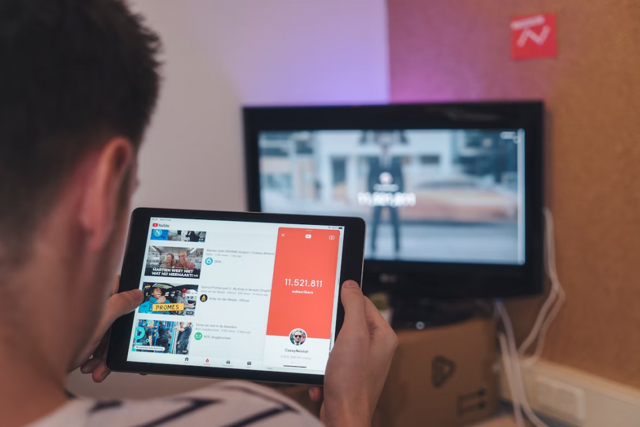The logo, color scheme, and just about any other piece of visual content you produce tell a lot about your company, mission, and mindset. The tricky part is knowing how to control your visual content marketing to build your brand and improve its appearance. Unfortunately, there’s no foolproof formula to making visual content work entirely in favor of your brand image.
However, plenty of ideas and techniques can help you streamline visual content to better represent your brand and improve its appearance, both among those who are aware of your company and those who aren’t.
Be Unique and Stand Out

Source: Unsplash
One of the hardest feats to accomplish in brand appearance is standing out among so many competitors. Companies will devote weeks, if not months of work in an attempt to distinguish themselves in a saturated market. While there are some very effective methods of improving brand appearance, the foundation of any good visual marketing campaign is to tell your company’s unique story.
For example, companies that grew from small startups are likelier to utilize playful visuals, such as colorful color schemes or animated advertisements, to say, “Yes, we are very serious about our work, but we also like to have some fun.” On the other hand, some companies prefer to tell the story of their business in a more professional tone, in which case they create infographics and utilize simple yet effective business logo designs to communicate how serious and focused they are about their work.
Take a step back and think about your company’s mission, how it was founded, why, and the vision that you have for its future. Even if your product or service is identical to other companies, your story will be one of a kind. Create visual branding that reflects your company’s uniqueness and you’re sure to stand out in a field of competitors.
Take a Page from Your Competitors’ Books

Source: Unsplash
As great as it is to tell your unique story through visual marketing, it’s also just as important to learn from the successes and failures of your competitors. This doesn’t mean copying their visual marketing strategies to a tee, but rather implementing some similar elements in your own branding.
Visual marketing isn’t a definite science, but some design techniques work better than others. A great example of effective design comes from fast food chains and brand colors. You’ll notice that many fast food chains use red in their branding and visual marketing. Why? Well, studies have shown that the color red acts as a psychological trigger that increases the appetite and makes people hungry.
Sure, there are still tons of fast food chains out there that don’t use red in their visual branding, but plenty of them do. This doesn’t mean that other fast food chains copy the successful branding strategies of McDonald's or KFC, but rather that they are aware of design techniques that are effective and use them to their advantage.
Observe the branding of your competitors and see what visual techniques or online video advertising trends they utilize in their branding and marketing strategies. See how these can be naturally incorporated into your own and how they can improve your brand image.
Feature Your Logo and Colors in All Your Marketing Content

Source: Unsplash
Brand recognition is a powerful tool, as customers create associations between ideas and your company. With brand recognition and association, clients are more likely to remember your services and are more likely to utilize them in the future. And one of the best ways to instill association among existing and prospective clients is through consistent brand exposure.
Displaying your visual marketing designs is key to developing brand recognition. The smallest eCommerce businesses will go out of their way to feature their logos and other design features in all of their marketing as possible, even if they are not as recognized as some of the bigger brands. This is because they know how effectively brand exposure through visual marketing content can improve brand recognition.
So how do you give your marketing designs the exposure they deserve? By strategically incorporating your company’s design features into every aspect of your marketing. One of the simplest steps to improving brand recognition is by using the company logo as a profile picture for all of the company’s social media accounts. It’s also very useful to include the logo as a watermark on social media posts, use brand colors in promotional videos, and feature slogans in your advertisements.
Have you noticed how there are so many companies that incorporate their company logo into the loading screen on their websites, platforms, and apps? It’s the perfect way for users to remember your logo as they wait for the page to load.
Live Events

Source: Unsplash
Even if your company is working on a purely digital product, there’s a lot to gain from live event promotion. Live events, in and of themselves, are a powerful form of marketing. After all, you’re getting potential clients personally involved in and engaged with your company outside of social media. This can be done through conferences that host influential speakers, demos of new products, entertainment lineups, and offer time for very useful networking. And above all, these events are a great place to utilize visual marketing.
Many brands host or participate in promotional events that feature a variety of activities, learning opportunities, and lots of useful networking. It’s during these live events that you can let your company’s visual marketing shine through several methods. Brochures, booklets, and banners that feature your company logo and colors put your brand in the spotlight, or demos of your products are all fantastic ways to utilize the strengths of your visual marketing during these events. Alternatively, you can display user-generated content from the event itself with a live slideshow gallery for everyone to see and get featured on.
Whether you’re hosting or participating in a live event, don’t miss the chance to present your brand designs front and center for everyone to see. This is the type of brand exposure you can’t afford to miss out on.
Work with In-House Designers

Source: Unsplash
The skills and experience of your designers are the lifeblood of successful visual marketing. Without them, you’d have to hire freelancers from different online platforms. Now, this isn’t to say that freelance designers are in any way less capable than an in-house team. There are tons of talented pros who choose a more flexible career and enjoy working on numerous projects at once.
However, you’ll find several advantages to having in-house (or at the very least, contract) designers who know their way around all the necessary visual design software to give you precisely the designs that you’re looking for. Why an in-house team? Because every minuscule detail is crucial to how effective your visual content will be. To accurately relay all your ideas, you need unhindered, direct communication and the complete focus of your designer.
This is not always the case with freelancers, who may be handling several projects at once. This obstacle is then magnified by difficulties in communication. In-house designers provide convenience for companies, as they can create, modify, and edit several design concepts with the direct input and feedback of the marketing team. Without an in-house team, communicating every tiny idea becomes much harder, leading to a slower design output where crucial details are lost in translation.
In-house designers are not just helpful, but paramount for the success of your company’s visual marketing and branding improvements.
Create a Mascot

Source: Unsplash
Besides static logos and other design features, brands are often interested in something more dynamic and “living” to represent them. And that’s why we have so many brand mascots. Ronald McDonald, the GEICO Gecko, and even those Coca-Cola winter holiday trucks are great examples of sales promotions with recognizable mascots that are effective at getting you to remember the brand they represent.
Mascots are powerful marketing tools that improve brand appearance and recognition. Even if some consumers don’t recognize your product, they’ll remember a unique and dynamic mascot. And the best part about them is that you can get pretty creative with who or what gets to represent your company.
Static mascots are quite popular for companies looking to spice up their logos and brand visuals. Animated mascots, both 2D and 3D, are great for advertisements and social media promotions, especially if they are voiced. Many companies find influencers and celebrities to represent them to a broader audience, making good use of their fanbase.
But at the end of the day, what matters most is that your mascot suits your company’s unique story and mission. Create a mascot that speaks to clients, and is also relatable to your brand and business.
Adapt to Your Demographics

Source: Unsplash
It’s hard to use visual marketing effectively when you don’t know who it’s speaking to. This is where research becomes one of the most potent tools in the hands of marketing specialists. Once you know who your visual marketing is targeting, you can streamline your promotional content and its distribution.
Let’s say you’ve posted a video and though it receives plenty of views from an audience spanning the globe, the click-through rate or engagement is not particularly high. Certain barriers prevent your audience from interacting with your brand any further. It may be something very delicate, such as the video not being particularly interesting. But on many occasions, it’s a very simple reason, such as a language or cultural barrier.
This is why companies working with international clients put great effort into video localization, which can be anything from including subtitles and dubbing, to creating an entirely different video that is more culturally appropriate for a certain demographic. This doesn’t mean abandoning your company image or values to connect with a very specific group of individuals. Instead, it means taking into account the diverse demographics that are exposed to your marketing content and adapting to their needs and preferences to improve audience engagement.
Make Your Visual Content Accessible

Source: Unsplash
To further expand on the idea of knowing your demographics, another important aspect of visual marketing is to make it accessible. Online marketing platforms and social media software have made it easier than ever to accommodate diverse audiences with their own unique needs.
A simple, yet very effective, example of making visual content accessible would be to put subtitles in all your videos. Not only does this help overcome language barriers, since subtitles are easier to translate than audible words, but it also helps those with hearing impairments as well.
When you consider that video hosting platforms like Youtube have very accurate automatic subtitle functions for videos, there’s no reason not to include them in your visual content. After adding subtitles to your videos, keep an eye on your Youtube video rank checker as you’ll surely see major improvements in your metrics. Another great way to make content more accessible is to have visual or contextual warnings for audience members with certain medical conditions, such as epilepsy.
These small steps say quite a lot about your company’s values and are a great way to improve brand image and make inclusive visual content. Even individuals with medical conditions can enjoy your visual content without having to jump through extra hoops to do so. Marketing and branding aside, this in and of itself is a respectable way of publishing content online. Consider the improved brand appearance a nice bonus.
Be True to Yourself

Source: Unsplash
You’ve likely heard this sentiment repeated a few times throughout this article — and for good reason. The essence of your brand should be the heart of any wholesome visual marketing campaign. Your brand appearance must stay true to the ethos of what your company is all about.
Ask yourself what you want your brand to be associated with when people look at your logo, videos on social media, and any other piece of marketing content your produce. Tell the genuine story of your company and all the people that make it work and this will surely improve the appearance of your brand in the eyes of clients, both old and new.
Audiences have a very keen instinct for spotting content that is not genuine. For example, big brands often make use of trends and memes by forcing them into their social media content plans, even if they don’t fit thematically or contextually. This, more often than not, backfires, as audiences can see through the facade of brands jumping on bandwagons solely to capitalize on their popularity.
Using visual content that is relevant to you doesn’t mean limiting what you can publish on social media platforms, nor does it mean that you should always post the same content. It simply means putting out content that is relevant to your brand and the work you do. Next time you’re filling out your social media content plan, check to see if what you’re publishing speaks true to your brand image.
What Social Media Platforms Say About Your Brand

Source: Unsplash
We can talk about branding all we want, but what is one place where virtual tons of visual content is consumed that you can use to strengthen your brand presence and recognition? Social media, of course, and we’ll start by looking into what each platform says about your brand.
Granted, social media platforms don’t divide companies into unique archetypes, since most big brands have an online presence on almost all platforms. For smaller brands, however, it’s not about expanding into as many social media platforms as possible, but rather into the ones that suit your brand’s unique voice and general way of doing things.
For example, companies that wish to market their down-to-earth values and create a more relatable online presence will focus their social media marketing efforts on platforms like Twitter, Facebook, and if they’re feeling brave, Reddit. Those looking to position themselves as purely
professional and nothing more will typically opt for LinkedIn and in some cases even Instagram, so long as their visual content can work with the Instagram ratio.
To Conclude
As you can see, there is a lot to cover with visual content and its effects on branding. There are plenty of marketing tips and tricks we did not cover, but needless to say: that would require a much lengthier article. For now, however, try to incorporate as many of these techniques into your marketing plan as possible, as they are great ways of improving brand appearance.
It’s also a lot of trial and error. As we said before, visual marketing, despite the many statistics we have on its effectiveness, is not a definite science. A multitude of factors and circumstances will determine how effective your brand image will be affected by visual marketing. But if you’re looking for a solid starting point, then the ideas we’ve mentioned above should do the trick.